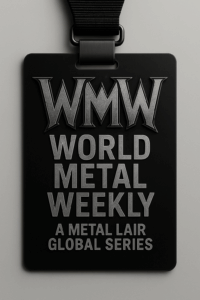The Dangerous Ones
Written By Sabbatha Ashvale
Welcome to Women in Metal. This isn’t your background playlist or some algorithm-friendly soundbite. These are the women who threatened the status quo. They didn’t just enter the boys’ club, they used it for bloodsport.
Metal didn’t just get infiltrated, it got breached. These weren’t scene darlings or hype cycles. They were walking detonators. They were proof that metal should never be safe.
Some self-destructed. some weaponized their bodies and some simply refused the leash. This isn’t about representation. This is about women who made the scene flinch.
The Underground Never Needed Your Approval
A Rip in Time: Women in Metal. A Metal Lair Original Series

A Rip in Time: Kim McAuliffe (Girlschool)
Girlschool were the first all-female NWOBHM band to break through on equal footing with men and the first to collaborate with Motörhead, with Lemmy treating them as peers, not novelty.
Girlschool came out of late-70s London, same smoke, same pubs, same NWOBHM pressure-cooker as Motörhead and Saxon.
Kim McAuliffe drove rhythm guitar and vocals like she had zero interest in proving anything, she was already equal.
When Motörhead merged with them under the hybrid name Headgirl and cut “Please Don’t Touch,” that wasn’t a novelty collab. That was Lemmy making it public record. They weren’t a cute exception. They could out groove half the guys in the room.
Moment: When Lemmy co-signed them as equals on wax, not as an opener. It wasn’t “Motörhead featuring a girl band.” It was collaboration. That was the breach point.
Track To Embed: Girlschool / Motörhead — “Please Don’t Touch” (Headgirl)
Why This One:
Because this is the tape where the lie breaks. Lemmy didn’t stamp them as a novelty act, he stamped them as peers. After this track existed, the scene could never again pretend women were “exceptions.”
A Rip in Time — Kathleen Hanna (Bikini Kill / Riot Grrrl)
Before metal ever learned to fear a woman with a mic, punk already had one who treated the stage like an execution platform.
Kathleen Hanna didn’t arrive to “represent” anything, she arrived to destroy the conditions that made representation necessary in the first place.
Riot grrrl was wasn’t branding, or style, or aesthetics, it was a jailbreak. She didn’t decorate the attic of punk, she burned the entire structural blueprint that kept women ornamental.
Kathleen is the pivot where fury stopped being a personality trait and became infrastructure. The industry wasn’t threatened by her volume, it was threatened by her refusal to be charming.
Every scream was a policy decision. Every lyric was a radical reframing of who gets to define reality in a scene built by men. Before her, female rage was a spectacle. After her, it was a doctrine.
Moment: Kathleen didn’t just scream, she engineered a cultural permission slip. Riot grrrl wasn’t a subgenre, it was a direct action. Female rage stopped being “attitude” and became a political instrument.
She didn’t ask for space, she stole the mic and dared the room to eject her. And the room blinked first. After Kathleen, “loud women” weren’t a spectacle, they were a threat.
Track to Embed: Bikini Kill — Rebel Girl
Why This One:
Because this is where the idea of palatable femininity got gunned down. This track is the inflection point where anger turned into strategy. Where the industry learned women weren’t there to be liked, they were there to detonate.
A Rip in Time – Otep Shamaya (Otep)
Otep Shamaya wasn’t let in, she barged in. When the business suits and scene dudes were still parroting “women can’t headline / can’t anchor a festival slot / can’t hold a pit,” she didn’t debate them, she sold out shows and kicked doors off hinges with her own name on the marquee.
She didn’t enter metal through networked favors or pedigree. She was a slam poet who turned her voice into a weapon and proved sheer force of presence can be its own infrastructure.
The industry didn’t know what to do with that kind of undeniability. So instead of bending her to fit the lane, she paved a new one by being infuriatingly unignorable.
The boys-club didn’t grant permission and she didn’t seek it. She simply made herself too powerful to exclude. she broke the “you don’t get to headline” ceiling by acting like that ceiling was beneath her.
When she stood up there alone under the lights, the stage finally had to admit she belonged because the crowd already knew.
Moment: When she headlined over male acts who were marketed as “above” her and the crowd preferred her set
Track To Embed: Battle Ready
Why This One:
Because this is the track where she’s not performing anger, she’s weaponizing it. Every cadence is a middle finger to the boys club bookers who swore women couldn’t anchor a bill.
A Rip in Time- Karyn Crisis (Crisis)
Karyn Crisis didn’t show up to compete with the boys.
she showed up like a message from a place the boys didn’t have access to. she wasn’t trying to be “metal’s toughest woman.” that’s a pedestrian category. she was operating in a different plane, she made extreme vocals feel like a transmission, not a gimmick. her power wasn’t volume, it was frequency. the room didn’t react like “wow she screams like a dude.” the room reacted like “this is not the same species.”
most women in metal were dismissed as novelties.
she wasn’t.
she was the thing the scene didn’t have language for yet. Crisis didn’t ask for space, she altered the environment until it bent around her. other women in the genre kicked doors. she made the walls breathe.
Moment: when Crisis headlined CBGB in the late 90s and men in the pit stopped trash-talking and started shutting up, not out of politeness but because they had no file in their head for what she was doing on that mic
Track To Embed: Sweething
Why This One:
This is the track where her voice stops being “harsh vocals” and turns into a channel. It’s not performance, it’s possession. the chaos has structure but no safety rails, and it proves she wasn’t trying to sound like a male frontman, she was transmitting something that metal didn’t have a name for yet.
A Rip In Time — Wendy O. Williams (Plasmatics)
Wendy O. Williams wasn’t a frontwoman, she was a controlled detonation in human form. while other artists talked about rebellion, she treated stages like crash sites with explosives, chainsaws, sledgehammers and cars demolished in real time.
She didn’t symbolize danger, she performed it. She wasn’t courting shock, She was documenting where reality failed to contain her.
The industry never decided if she was an icon or a felony waiting for a court date. You didn’t watch her to be entertained, you watched her because part of you didn’t believe a human could survive the things she did on stage.
She didn’t “push boundaries,” she pulverized them and then asked why they were ever considered unbreakable in the first place.
Wendy’s recklessness wasn’t apathy, it was over-voltage. She was wired too hot for ordinary life. Those stunts weren’t “look at me,” they read like someone who refused the cage.
She lived like a person who’d already decided she wasn’t going to make it to old age so she wasn’t going to dilute herself to fit inside in the meantime.
From the outside it looked like “she didn’t care,” but from the inside it was closer to, this world isn’t big enough to contain the thing I actually am.
Wendy wasn’t reckless because she didn’t care. She cared so much it scorched her. She cared about autonomy, anti-corporate and anti-plastic America.
She cared about ripping open the hypocrisy in puritan culture, about women not being props and she cared about America’s weird double standard: “sex is evil” but “violence is patriotic.”
So she weaponized the very things the culture policed, her body plus destruction. Her entire aesthetic was performance art more than metal frontwoman”
She wasn’t self-destructive for the thrill. She was trying to show how disposable we make women who don’t obey.
That’s a different animal and there’s tragedy in it. But there’s also a sort of brutal honesty. She didn’t perform danger, she was danger.
She never pretended life had guardrails…that level of intensity almost always ends badly.
Wendy wasn’t “just a wild frontwoman who got naked and blew up cars.”
She belonged to a family of women who took the female body, the thing society tries hardest to regulate and turned it into a broadcast tower of resistance.
Valie Export did it in galleries, Lydia Lunch did it in downtown NY noise art. Wendy did it in metal and punk clubs with a shotgun and a sneer. Different mediums, same war.
Moment: The televised Plasmatics car explosion and chainsaw performance where she turned a TV studio into a blast zone and made the entire music business look timid by comparison
Track To Embed: Plasmatics – Butcher Baby
Why This One:
Because it isn’t metaphor and it’s a threat. this isn’t shock rock for attention, this is a woman turning destruction into a language. There’s no “female fronted novelty” here, there’s only combustion.
Missed last weeks A Rip in Time: Women in Metal? We’ve got you covered.
Prologue
Here’s the crime scene, the damage, the breach point and here’s who actually detonated the genre.
Metal didn’t bloom in a single lineage; it ruptured in multiple directions. Women were the rupture, not the footnote.
This isn’t anti-establishment. It’s anti-revisionism. And when the timeline gets corrected, when the evidence sits there in black ink, static-free and undeniable, those secure in their legacy won’t feel threatened. Lemmy sure as hell wasn’t. He co-signed Girlschool, recognized Wendy O. as a peer, and didn’t need the throne to feel like a king.
What we’re doing isn’t a hit piece; it’s historical correction.
Metal didn’t ask for permission and neither did the women who helped rewired it.
Q: What is A Rip in Time: Women in Metal?
A Rip in Time is Metal Lair’s ongoing tribute to the women who’ve reshaped heavy music. Each installment spotlights a groundbreaking artist who challenged the genre’s boundaries from vocal ferocity to creative evolution, showing that metal’s history isn’t just told through distortion, but through defiance.
Q: What makes this series different?
It’s not a checklist of “women in metal.” It’s a time-ripping journey through eras, sounds, and revolutions. Each feature dives into how these artists rewrote their own rules, their riffs, their philosophies, their fire.
Q: Who’s been featured so far?
Each chapter covers a distinct voice in metal’s lineage. Figures like Doro Pesch, Floor Jansen, Angela Gossow, Sabina Classen, and Tatiana Shmailyuk, with more icons and unsung heroes to come.
Q: How often does the series update?
A Rip in Time appears periodically throughout the year as new chapters are researched and written. It’s designed to evolve, not just repeat.
Q: Does Metal Lair have other series like this?
Yes! Metal Lair runs several signature series that explore every corner of heavy music:
- Seven Deadly Songs – A weekly roundup of the most unholy new releases.
- Deep Cuts – Hidden gems and lost recordings from rock and metal history.
- Metalhead Horoscopes – Weekly forecasts laced with riffs, attitude, and a lucky song for every sign.
- World Metal Weekly – A global passport through the underground, one country at a time.










